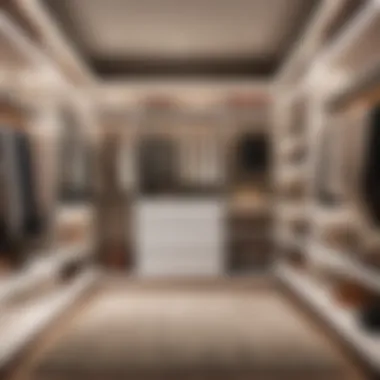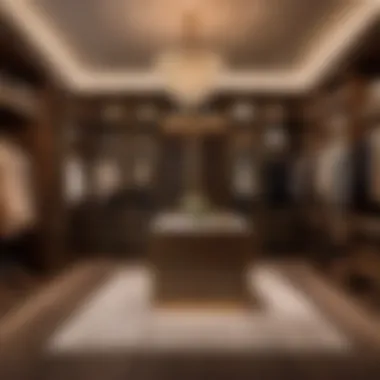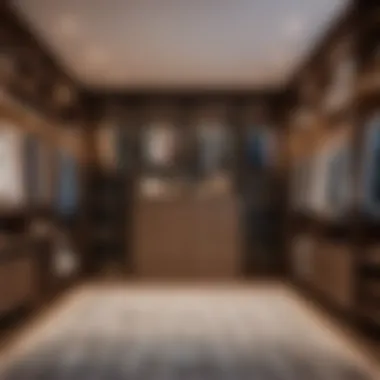Transforming a Small Bedroom into a Stylish Closet: An In-depth Guide for Efficiency


Materials:
- Measuring tape: 1 unit (for accurately measuring the dimensions of the room and furniture)
- Storage containers: 10 units (for organizing and storing clothing items)
- Clothing racks: 2 units (to hang clothes efficiently)
- Shelving units: 3 units (for additional storage space)
- Decorative hooks: 5 units (for hanging accessories)
DIY Steps:
- Measure the dimensions of the bedroom to plan the layout of the closet space effectively.
- Declutter the room by removing unnecessary items and clothes to create a blank canvas.
- Install clothing racks for hanging clothes and shelving units for folded items.
- Use storage containers to organize and categorize different clothing items for easy accessibility.
- Add decorative hooks for hanging accessories like scarves and bags.
Technical Aspects:
- Tools required: Screwdriver, drill, hammer, level
- Timing specifics: Approximately 2-3 days for completion
- Critical techniques: Ensure proper spacing between clothing racks and shelves for a streamlined look
DIY Project Process:
- Start by measuring the dimensions of the room and marking where each storage solution will be placed.
- Clear out the bedroom completely to have a clean slate for the transformation process.
- Begin with installing the clothing racks, ensuring they are securely mounted to the wall.
- Proceed with assembling and placing the shelving units for folded clothing and accessories.
- Utilize the storage containers to categorize and store clothing items based on type or season.
Troubleshooting Tips:
- If space is limited, consider utilizing vertical storage solutions to maximize available space.
- Ensure proper ventilation in the closet area to prevent moisture buildup.
- Regularly assess and declutter the closet to maintain an organized space.
Introduction
Transforming a small bedroom into a closet is a practical and aesthetically pleasing solution for individuals seeking to optimize their living space efficiently. In this comprehensive guide, we delve into the intricacies of this transformation, providing a detailed roadmap for those looking to revamp their personal storage area into a functional and stylish closet space. From the initial planning stages to the final touches, every aspect of this conversion process will be explored, offering valuable insights and practical tips for readers.
Understanding the Importance of Closet Space
Closet space is a fundamental element in any home, ensuring that clothing, shoes, and accessories are organized and easily accessible. By converting a small bedroom into a closet, individuals can customize the storage layout according to their needs, maximizing the utilization of space while enhancing the overall aesthetics of the room. The importance of closet space lies in its ability to streamline daily routines, avoid clutter, and create a visually appealing environment that boosts efficiency and organization.
Benefits of Converting a Bedroom into a Closet
Converting a bedroom into a closet presents a myriad of benefits for homeowners. Firstly, it allows for a dedicated storage area that caters specifically to clothing and accessories, reducing clutter in other parts of the house. Secondly, this transformation enables individuals to tailor the closet layout to their preferences, incorporating personalized storage solutions that suit their organizational habits. Additionally, repurposing a bedroom into a closet offers a creative and practical way to make use of underutilized space, adding value and functionality to the home.
Setting Realistic Goals for the Transformation
Before embarking on the journey of converting a bedroom into a closet, it is crucial to set realistic goals to guide the transformation process. This involves assessing the available space, understanding the storage needs, and envisioning the desired layout and design elements. By establishing clear objectives and expectations from the outset, individuals can make informed decisions regarding decluttering, storage solutions, and decorative touches, ensuring that the end result aligns with their vision and practical requirements.
Planning and Preparation


In the process of transforming a small bedroom into a closet, meticulous planning and preparation play a pivotal role in ensuring a successful outcome. This phase sets the foundation for the entire project and dictates how smoothly the transition will be from a sleeping space to a storage area. Planning includes assessing the available space, understanding the structural constraints, and determining the specific needs of the individual. It is essential to take into account the dimensions of the room, existing furnishings, and any limitations that may impact the layout of the future closet. By carefully planning each step, one can avoid costly mistakes and optimize the utilization of the available space efficiently.
Measuring dimensions
Measuring the dimensions of the bedroom accurately is a critical aspect of planning the transformation. By taking precise measurements of the room, including the length, width, and height, individuals can determine the feasibility of converting the space into a closet. These measurements are essential for designing shelving units, determining hanging space, and assessing the overall layout of the closet area. Accurate measurements ensure that the final design fits seamlessly into the available space, maximizing functionality and aesthetic appeal.
Identifying structural constraints
Identifying the structural constraints of the bedroom is another crucial component of the planning phase. Structural constraints may include elements such as windows, doors, electrical outlets, and architectural features that need to be considered when reconfiguring the room into a closet. Understanding these constraints helps individuals create a design that works harmoniously with the existing structure, avoiding unnecessary alterations or compromises in the overall layout. By analyzing the structural aspects of the space early in the planning process, one can develop a realistic vision for the closet transformation that aligns with both practicality and aesthetics.
Decluttering and Sorting Items
Decluttering and sorting items are integral steps in the transformation process, as they pave the way for a streamlined and organized closet area. This phase involves systematically categorizing belongings, determining what to keep, and disposing of unnecessary items to create a clean and functional space. By decluttering effectively, individuals can optimize the storage capacity of the closet and enhance accessibility to their wardrobe essentials.
Organizing belongings
Organizing belongings involves creating a systematic approach to arranging clothing, accessories, and other items within the closet. By categorizing items based on frequency of use, seasonality, or type, individuals can optimize the layout of the closet for ease of access and visual appeal. Utilizing storage solutions such as bins, baskets, and dividers can help maintain order and enhance the overall organization of the space, making it easier to locate specific items quickly.
Discarding unnecessary items
Discarding unnecessary items is a crucial step in decluttering the bedroom to create a functional closet space. By assessing each item and its relevance to personal style or practicality, individuals can make informed decisions about what to keep, donate, or discard. Removing items that are no longer needed eliminates clutter, frees up valuable storage space, and allows for a more streamlined wardrobe area. This process of purging and editing belongings sets the stage for a purposeful and efficient closet layout that reflects the individual's unique lifestyle and preferences.
Determining Storage Needs
Determining storage needs is a vital aspect of the closet transformation process, as it influences the design and functionality of the space. By understanding the specific storage requirements based on wardrobe size, usage patterns, and personal preferences, individuals can tailor the closet layout to meet their individual needs effectively.
Estimating hanging space
Estimating the hanging space needed in the closet involves evaluating the quantity and types of clothing that require hanging storage. By estimating the amount of hanging space needed for items such as dresses, suits, and coats, individuals can design a closet layout that accommodates these garments without overcrowding the space. Incorporating adjustable rods and hooks allows for flexibility in hanging configurations, making it easier to reorganize clothing based on seasonal changes or preference.
Evaluating shelving requirements
Evaluating shelving requirements is essential for creating a functional and organized closet space. By assessing the need for shelves to store folded clothing, shoes, accessories, and other items, individuals can design a shelving system that maximizes storage capacity and accessibility. Adjustable shelves offer versatility in accommodating items of varying sizes and can be reconfigured to adapt to changing storage needs over time. By carefully evaluating shelving requirements, individuals can create a customized storage solution that optimizes space utilization and enhances the overall functionality of the closet.
Optimizing Storage Solutions
When it comes to transforming a small bedroom into a closet, optimizing storage solutions plays a pivotal role in maximizing space efficiency and maintaining organization. By strategically utilizing closet organizers, customized shelving units, drawers, and cabinets, individuals can create a functional and stylish storage area that suits their specific needs and preferences. This section will delve into the various aspects of optimizing storage solutions to help you achieve a well-organized and visually appealing closet space.


Utilizing Closet Organizers
Closet organizers are essential tools for streamlining storage and keeping belongings in order. By installing racks and hooks, you can efficiently store items such as bags, scarves, and accessories, maximizing vertical space and ensuring easy accessibility. These organizers help in decluttering and creating a systematic layout within the closet, enhancing convenience and practicality.
Installing Racks and Hooks
Installing racks and hooks allows for the efficient organization of clothing and accessories. These fixtures provide a strategic storage solution, utilizing wall space effectively and freeing up valuable shelf and floor space. The key characteristic of racks and hooks is their versatility, allowing for customizable arrangements based on individual storage needs. This flexibility makes them a popular choice for optimizing storage solutions in small closets, offering easy access to frequently used items while maintaining a neat and tidy environment.
Using Bins and Baskets
Incorporating bins and baskets into the closet design enhances storage capacity and facilitates systematic organization. These containers are ideal for storing folded clothes, shoes, or miscellaneous items, creating designated compartments for different categories of belongings. The unique feature of bins and baskets lies in their ability to conceal clutter while adding a decorative element to the closet. However, careful consideration is required to avoid overcrowding and ensure that items are easily accessible when needed.
Customizing Shelving Units
Customizing shelving units is crucial for optimizing storage space and accommodating varying closet contents. Adjustable shelves enable efficient storage of items with different dimensions and quantities, offering flexibility in shelving arrangements to suit changing needs. By maximizing vertical space, individuals can utilize the full height of the closet, creating additional storage without compromising accessibility or aesthetics.
Incorporating Adjustable Shelves
Incorporating adjustable shelves allows for versatile storage options, accommodating items of various sizes while maximizing vertical space utilization. The key characteristic of adjustable shelves is their adaptability, enabling users to reconfigure shelf heights based on the evolving storage requirements. This feature makes them a practical choice for small closets, where space optimization is essential for maintaining organization and accessibility.
Maximizing Vertical Space
Maximizing vertical space is a strategic approach to enhancing storage capacity in a compact closet. By utilizing tall shelves or hanging organizers, individuals can capitalize on the height of the room, storing seasonal items or less frequently used belongings in upper compartments. This practice optimizes floor space and prevents overcrowding, creating a visually appealing and well-organized storage solution. However, careful planning is needed to ensure that items stored in high spaces are accessible without difficulty.
Integrating Drawers and Cabinets
Integrating drawers and cabinets adds a level of sophistication to the closet while offering discreet storage for personal items and accessories. Selecting drawer organizers ensures systematic arrangement of clothing items, jewelry, or small accessories, facilitating easy retrieval and maintaining order within the closet. Similarly, installing cabinet doors conceals belongings, creating a clean and cohesive look while safeguarding items from dust and damage.
Selecting Drawer Organizers
Choosing the right drawer organizers enhances storage efficiency and keeps items neatly divided within the closet. Drawer organizers come in various sizes and configurations to accommodate different types of accessories, from socks and underwear to jewelry and watches. The key characteristic of drawer organizers is their compartmentalized design, allowing for meticulous organization and easy identification of stored items. This feature makes them a popular choice for individuals seeking a clutter-free and visually appealing closet space.
Installing Cabinet Doors
Installing cabinet doors adds a touch of elegance to the closet while concealing belongings for a clean and polished appearance. Cabinet doors come in different styles and materials, allowing for customization to match the overall aesthetic of the room. The unique feature of cabinet doors lies in their ability to hide clutter, creating a minimalistic and sleek look that complements the design of the closet. However, it's essential to consider the functionality of the doors in terms of ease of access and visibility of stored items to ensure practicality alongside aesthetics in the closet design.
Design and écor Elements


In this article, the Design and Décor Elements section plays a vital role in elevating the aesthetics and functionality of the transformed closet space. Design and décor elements are crucial in creating a visually pleasing and harmonious environment that reflects the owner's personal style and enhances the overall appeal of the space. By carefully considering and implementing various design and décor aspects, individuals can elevate their closet from a mere storage area to a chic and personalized retreat.
Color Palette and Lighting
Choosing a Neutral Color Scheme
Choosing a neutral color scheme is a key aspect of the design and décor elements when transforming a small bedroom into a closet. The neutral color palette offers versatility, timelessness, and a sense of calm to the space. By opting for colors such as white, beige, gray, or soft pastels, individuals can create a neutral backdrop that allows their clothing and accessories to stand out. The neutrality of these colors also makes it easier to coordinate different design elements and change accent pieces without clashing. Additionally, neutral colors contribute to a sense of spaciousness, especially in small areas, by reflecting light and creating an illusion of expansiveness.
Implementing Adequate Lighting
Implementing adequate lighting is another critical component of the design and décor elements in the closet transformation process. Proper lighting is essential for illuminating the space effectively, highlighting the wardrobe contents, and ensuring a functional and visually appealing layout. By incorporating a mix of ambient, task, and accent lighting, individuals can create a well-lit environment that enhances visibility and ambiance. Adequate lighting helps in differentiating clothing colors accurately, facilitating outfit selection, and creating a cozy atmosphere within the closet. Moreover, strategic placement of light sources such as overhead fixtures, LED strip lights, and vanity lighting can further enhance the aesthetics and functionality of the space.
Mirror Installations
Strategic Placement of Mirrors
Strategic placement of mirrors holds significant importance in the design and décor elements of the transformed closet. Mirrors serve a dual purpose - they visually expand the space by reflecting light and creating an illusion of depth, and they aid in outfit selection and evaluation. Placing mirrors on closet doors or walls opposite windows can amplify natural light and make the space appear larger and brighter. Additionally, strategic mirror placement allows individuals to check their outfits from various angles, ensuring a seamless and coordinated look.
Enhancing Visual Appeal
Enhancing visual appeal through mirrors adds a touch of sophistication and elegance to the closet space. Mirrors not only serve a functional purpose but also act as decorative elements that elevate the overall design aesthetic. By selecting mirrors with unique frames or shapes, individuals can infuse personality into the space and create a focal point. Furthermore, mirrors reflect surrounding décor elements, such as lighting fixtures and accessories, enhancing the visual interest and depth of the closet.
Incorporating Personal Touches
Displaying Accessories
Displaying accessories is a key aspect of personalizing the closet space and adding a touch of style and individuality. By showcasing accessories such as jewelry, scarves, or handbags, individuals can transform their closet into a curated display of personal items. Using jewelry stands, accessory trays, or decorative hooks, individuals can organize and display their accessories in an aesthetically pleasing manner, making them easily accessible while enhancing the overall visual appeal of the space.
Adding Decorative Elements
Adding decorative elements such as artwork, plants, or decorative storage containers infuses character and warmth into the closet environment. Decorative elements serve as finishing touches that tie the design elements together and create a cohesive and inviting atmosphere. By incorporating decorative elements that resonate with their personal style, individuals can enhance the ambiance of the closet, turning it into a retreat where they can relax and enjoy the process of selecting outfits.
Finishing Touches and Organization Tips
In the realm of transforming a small bedroom into an efficient and stylish closet, the finishing touches and organization tips play a pivotal role in ensuring the final outcome is not just functional but also aesthetically pleasing. These elements are the cherry on top, refining the space to reflect personal style and maximizing practicality.
When it comes to maintaining order and accessibility within the newly transformed closet, incorporating a regular decluttering routine is crucial. This practice involves systematically going through belongings, evaluating what is still useful, and effectively getting rid of items that no longer serve a purpose. By implementing a consistent decluttering schedule, individuals can prevent unnecessary accumulation, maintain a tidy environment, and enhance the overall efficiency of the closet. The key characteristic of a regular decluttering routine is its proactive approach in preventing clutter build-up, allowing for easier organization and navigation within the space.
Utilizing labels and storage bins is another essential aspect of organizing a closet effectively. Labels provide clarity and structure, making it easier to locate specific items without rummaging through piles. Storage bins help categorize belongings, maximize space utilization, and maintain a neat appearance. The unique feature of utilizing labels and storage bins is the ability to create a systematic storage system that is both functional and visually appealing. While the advantages include streamlined organization and quick retrieval of items, potential disadvantages could be over-reliance on labeling and a need for commitment to maintaining the system over time.
Creating a functional layout is imperative in optimizing the use of space within the closet. Clothing categorization involves arranging garments by type, season, or color to facilitate easy access and efficient storage. This method promotes a structured approach to wardrobe organization, simplifying daily outfit selection and management. The key characteristic of clothing categorization is its ability to minimize clutter and enhance visibility, allowing individuals to make the most of their wardrobe space.
Zone-based organization refers to dividing the closet into specific zones or sections based on the frequency of use or item category. By creating designated areas for different types of clothing or accessories, individuals can maintain a systematic layout that promotes organization and accessibility. The key advantage of zone-based organization is its tailored approach, allowing for customized storage solutions tailored to individual needs. While this method enhances organization efficiency, potential disadvantages may include the need for regular maintenance to uphold the designated zones.
Incorporating aesthetic elements such as displaying jewelry and shoes adds a touch of personalization and elegance to the closet space. Strategic placement of accessories not only showcases personal style but also ensures easy access and visibility. Utilizing decorative storage options like bins, boxes, or elegant containers further enhances the visual appeal of the closet while providing additional storage solutions. The unique feature of displaying jewelry and shoes and utilizing decorative storage lies in their ability to elevate the ambiance of the space, turning it into a luxurious and functional wardrobe area. While the advantages include enhanced aesthetics and increased storage capacity, potential disadvantages could include the need for regular cleaning and organization maintenance.







